In the realm of student teaching, the integration of technology, particularly AI-generated lesson plans, has introduced a new dynamic. However, it also brings to light crucial questions regarding lesson plans, AI detection, and the development of teaching competence. As educational landscapes evolve, understanding these aspects is essential for nurturing effective future teachers.

The Rise of AI in Lesson Planning
AI has made significant inroads into education, especially in lesson planning. With the ability to analyze vast amounts of educational data, AI can generate detailed lesson plans tailored to specific learning objectives. For example, it can suggest teaching methods, learning materials, and assessment strategies. This innovation has the potential to save time and offer fresh perspectives for student teachers. According to TeachThought’s article on AI in education, AI tools can streamline the planning process and provide evidence-based suggestions. However, this convenience comes with its own set of challenges.
The Limitations of AI-Generated Lesson Plans
One major limitation is the lack of real-life context and adaptability. AI-generated plans may not account for the unique characteristics of a particular classroom, such as students’ diverse learning styles and backgrounds. A rigid plan might not be able to adjust to unexpected classroom situations. Moreover, relying too heavily on AI-generated plans can hinder the development of a student teacher’s critical thinking and creativity. These skills are fundamental in tailoring lessons to the specific needs of students. As ASCD’s research on teacher creativity in the AI era indicates, over-reliance on AI can lead to a decrease in teachers’ ability to think on their feet and make on-the-spot adjustments.

Another issue is the potential for ethical concerns. There is a risk of plagiarism if AI-generated content is not properly attributed. Additionally, AI systems may have biases in the data they are trained on, which could translate into unfair or inaccurate lesson plans. This emphasizes the need for strict AI detection mechanisms in educational institutions.
In addition to these, AI-generated lesson plans lack the human touch. The ability to connect with students on an emotional level, understand their non-verbal cues, and build relationships is a crucial aspect of teaching that AI simply cannot replicate.
Readability guidance: The paragraphs above discuss the rise and limitations of AI in lesson planning. Short paragraphs are used to clearly present each point, and external links are provided for further reference. Transition words like ‘however’ and’moreover’ are used to connect ideas smoothly.


